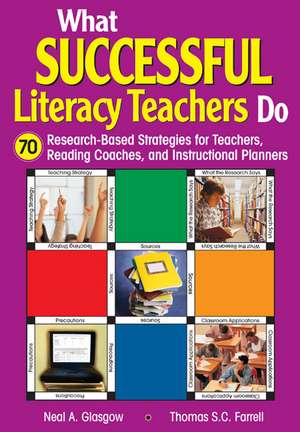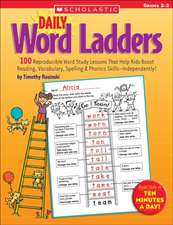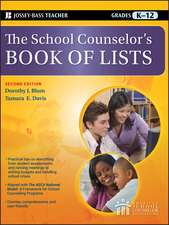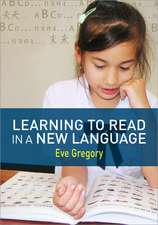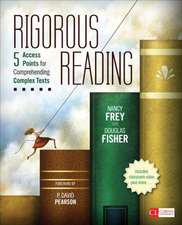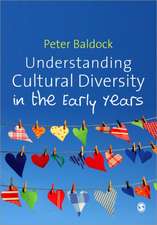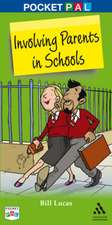What Successful Literacy Teachers Do: 70 Research-Based Strategies for Teachers, Reading Coaches, and Instructional Planners
Autor Neal A. Glasgow, Thomas S. C. Farrellen Limba Engleză Paperback – 19 iun 2007
• A concise description of the recommended classroom strategy or application;
• A brief synthesis of the research that supports use of the strategy;
• Guidelines for applying the strategy in the classroom;
• Precautions about avoiding pitfalls that may occur during implementation of the strategy; and
• Source citations for further research and follow-up.
The book includes coverage of research linked to current legislation and controversy ("the reading wars"), including Reading First, scripted reading programs, "evidence" and bilingual learning, but it does not favour or promote specific programmes. The focus always remains on state-of-the-art research translated into practitioner strategies for real learners in real classrooms.
| Toate formatele și edițiile | Preț | Express |
|---|---|---|
| Paperback (1) | 281.67 lei 6-8 săpt. | |
| SAGE Publications – 19 iun 2007 | 281.67 lei 6-8 săpt. | |
| Hardback (1) | 514.89 lei 6-8 săpt. | |
| SAGE Publications – 19 iun 2007 | 514.89 lei 6-8 săpt. |
Preț: 281.67 lei
Nou
53.90€ • 55.96$ • 44.95£
Carte tipărită la comandă
Livrare economică 24 martie-07 aprilie
Specificații
ISBN-10: 1412916151
Pagini: 184
Dimensiuni: 178 x 254 x 12 mm
Greutate: 0.39 kg
Ediția:1
Editura: SAGE Publications
Colecția Corwin
Locul publicării:Thousand Oaks, United States
Recenzii
"I liked that way the book was organized. It was easy to read quickly, especially when looking for something specific. I definitely enjoyed the quotes to start each chapter and the research for each strategy."
"Packs in literacy strategies to help teachers. From phonics and vocabulary and word study to assessment strategies and ESL challenges, this links six decades of reading research to classroom instruction success stories for maximum value."
“While each strategy is research based and a brief summary of the research and sources are given, the book’s value is in the descriptions of the classroom application of each strategy. Even better is the ‘precautions and possible pitfalls’ section for each strategy that steers the practitioner away from common mistakes that would impede successful implementation. Both new classroom teachers and experienced literacy coaches will be able to find classroom techniques that will assist students in becoming literate adults.”
Cuprins
Preface
Acknowledgments
About the Authors
Introduction
1. The Very Complex and Often Controversial History, Philosophy, and Theory of Reading and Literacy
2. Phonics, Phonemics, and Decoding
Strategy 1. "Sound it out": Coach word recognition in beginning reading.
Strategy 2. Teach phonemic awareness and phonics in the classroom and at home.
Strategy 3. Use decoding to improve word identification problems and improve fluency.
Strategy 4. Use drama rhymes to teach reading.
Strategy 5. Consider visual-syntactic text formatting for digital text as a technique for increased academic achievement and long-term reading proficiency.
3. Vocabulary, Spelling, and Word Study
Strategy 6. Revisit and reconsider the role that vocabulary instruction plays in comprehension and reading motivation.
Strategy 7. Use teacher "read-alouds" as an effective practice for enhancing two of the critical components of reading instruction.
Strategy 8. Use semantic impressions to teach vocabulary.
Strategy 9. Use word expert cards to teach vocabulary.
Strategy 10. Whether you develop your own word-study/spelling approach or teach with a published program of some type, you need to match the specific system with the developmental stages of the learners.
4. Fluency
Strategy 11. With the right strategies, reading fluency can be improved in middle and high school classrooms.
Strategy 12. Let learners read as much as possible.
Strategy 13. We are all reading teachers and we should act as reading role models.
Strategy 14. Keep in mind the three key elements of reading fluency: accuracy in word decoding, automaticity in recognizing words, and the use of meaningful oral expression and learn how to address them within instruction.
5. Comprehension
Strategy 15. Try a "thinking out loud strategy" to help reveal children's thought processes as they try and make sense of text.
Strategy 16. Use information trade book retellings to improve student comprehension of expository text structures.
Strategy 17. Explore these three ways to get students to interact with the text in reading classes: summarize, share insights, and question.
Strategy 18. Use drama techniques such as drawing, interviewing, and story theater in the class to help students interact with the text.
Strategy 19. Allow students to choose what they want to read.
Strategy 20. Use paraphrasing to promote reading comprehension.
Strategy 21. Develop critical thinking and reasoning ability through the use of fiction and nonfiction books in the content areas.
Strategy 22. Use talk as a strategy in the reading class.
Strategy 23. Use scaffolding to improve reading comprehension.
Strategy 24. Teach young children "radical change" characteristics in picture books.
6. Interventions for Struggling and At-Risk Readers
Strategy 25. Don't wait for formal testing to begin interventions for students with reading disabilities.
Strategy 26. Use early literacy intervention strategies to facilitate appropriate student behavior.
Strategy 27. Consider consulting with the speech pathologists to create a multifaceted approach to build students' vocabulary and assist them in reading comprehension.
Strategy 28. Consider peer tutoring, especially cross-age tutoring, as an appropriate intervention for students whose struggle to read continues to be significantly below grade level.
Strategy 29.Make it routine practice to foster self-efficacy and motivation in your young readers.
Strategy 30.Remember deficits in reading ability are often associated with a complex range of issues beyond academic achievement, such as lack of motivation, poor self-esteem, and difficult social settings.
Strategy 31.Examine the effects of reading interventions on social outcomes for struggling elementary school readers.
Strategy 32. Be patient with "slower learners" who require more reading practice than other students.
Strategy 33.Create a partnership between general education teachers and special educators using a shared classroom literacy program.
7. Help for English Language Learners
Strategy 34.Explore the definition of literacy and the complexity of the term when applied to bilingual and bicultural students.
Strategy 35.In multicultural classrooms, reflect on the literacy instructional practices of the countries your students come from and how these practices affect their performance in U.S. schools.
Strategy 36.Consider the variety of elements that support literacy intervention for young English-language learners.
Strategy 37.Don't forget visual texts or "reading pictures," either literary or factual, can be a powerful medium for learning and can assist L2 learners' literacy development.
Strategy 38.Use learners' native languages in literacy instruction.
Strategy 39.For second-language learners, teach reading before testing it.
Strategy 40.Use similarities between Spanish and English to facilitate spelling instruction.
8. Literacy Instruction and Assessment Across the Curriculum
Strategy 41. When grading a student's writing, consider what the student is able to do well before noting what needs improvement.
Strategy 42. Consider the use of open-book tests to promote and encourage the assigned textbook reading and the skills required to quickly find and utilize information.
Strategy 43.Move beyond the simplistic notion of a "balanced approach to literacy instruction" and explore more fully what it means to be a literate person and how we can help students.
Strategy 44.Reexamine the nature of "content literacy" and how it is reflected in your professional approach to literacy-related activities in your classroom.
Strategy 45.As a content teacher, learn to carefully select literacy instructional design principles that have been documented to improve comprehension of specific content, skills and higher-order thinking.
Strategy 46.Consider popular song lyrics as a "prereading" vehicle to help create a motivating context for more specific subject matter concepts.
9. Literacy and Instructional Materials
Strategy 47.Use your school hallways and other public areas at school to display the use of a variety of literacies as they provide insights into how literacy is practiced and valued (or devalued) in schools.
Strategy 48.Help youngboys make a positive and compatible connection between masculinity and success as readers.
Strategy 49. Include multicultural works when developing a quality English curriculum.
Strategy 50. Take a look at one of the best resources for recommended literature available, the "Recommended Literature: Kindergarten Through Grade Twelve" on the California Department of Education's Web site.
Strategy 51.Use folk literature in the reading class.
Strategy 52.Let children read and write great poetry.
Strategy 53.Use nonfiction readings in the primary grades.
10. Family and Community Literacy
Strategy 54.Utilize a variety of print materials to inspire student reading and writing.
Strategy 55.Encourage use of libraries to provide a more inclusive literature collection for sexual minorities.
Strategy 56.Reflect on the complex issues surrounding school literature selection for bilingual and bicultural students.
Strategy 57.Find the "out-of-classroom" forces that shape reading habits and reading choices of young people to better develop their personal reading interests.
Strategy 58.Don't overlook the obvious, the public library and the library card, as motivating factor within your literacy strategies.
Strategy 59.Literacy programs work best by involving the whole family.
Strategy 60.Explore ways parents can help their children read at home.
Strategy 61.Make children aware of community library literacy programs.
Strategy 62.Rather than imposing a school literacy curriculum on parents, consider listening to the parents' voices about a shared curriculum.
Strategy 63.Become an advocate for improved home literacy environments (HLE) for all students, especially for preschool and K-3 students.
11. Literacy, Technology, and the Internet
Strategy 64.Optimize the purchase and use of word-processing spell-checker programs to better serve the needs of students with learning disabilities.
Strategy 65.Become just as familiar with literacy-useful software as you are with your students' favorite literature.
Strategy 66.Look to children's "out-of-school" uses of the Internet for instructional reading strategies for the classroom.
Strategy 67.For children with reading difficulties, text-to-speech software offers some of the benefits of shared reading.
Strategy 68.Use the Internet to improve reading comprehension
Strategy 69.Use electronic pen pals (ePALS) to have students communicate with people and sites beyond the classroom.
Strategy 70.Use CD-ROM storybooks with early readers.
Index
Notă biografică
Neal A. Glasgow¿s experience includes serving as a secondary school science and art teacher both in California and New York, as a university biotechnology teaching laboratory director and laboratory technician, and as an educational consultant and frequent speaker on many educational topics. He is the author or coauthor of ten books on educational topics: What Successful Schools Do to Involve Families: Fifty Research-Based Strategies for Teachers and Administrators (2008), What Successful Literacy Teachers Do: 70 Research-Based Strategies for Teachers, Reading Coaches, and Instructional Planners (2007), What Successful Teachers Do in Diverse Classrooms: 71 Research-Based Strategies for New and Veteran Teachers (2006); What Successful Teachers Do in Inclusive Classrooms: 60 Research-Based Strategies That Help Special Learners (2005); What Successful Mentors Do: 81 Researched-Based Strategies for New Teacher Induction, Training, and Support (2004); What Successful Teachers Do: 91 Research-Based Strategies for New and Veteran Teachers (2003); Tips for Science Teachers: Research-Based Strategies to Help Students Learn (2001); New Curriculum for New Times: A Guide to Student-Centered, Problem-Based Learning (1997); Doing Science: Innovative Curriculum Beyond the Textbook for the Life Sciences (1997); and Taking the Classroom to the Community: A Guidebook (1996).
